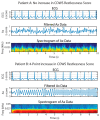Leveraging Accelerometry as a Prognostic Indicator for Increase in Opioid Withdrawal Symptoms
- PMID: 36354433
- PMCID: PMC9688173
- DOI: 10.3390/bios12110924
Leveraging Accelerometry as a Prognostic Indicator for Increase in Opioid Withdrawal Symptoms
Abstract
Treating opioid use disorder (OUD) is a significant healthcare challenge in the United States. Remaining abstinent from opioids is challenging for individuals with OUD due to withdrawal symptoms that include restlessness. However, to our knowledge, studies of acute withdrawal have not quantified restlessness using involuntary movements. We hypothesized that wearable accelerometry placed mid-sternum could be used to detect withdrawal-related restlessness in patients with OUD. To study this, 23 patients with OUD undergoing active withdrawal participated in a protocol involving wearable accelerometry, opioid cues to elicit craving, and non-invasive Vagal Nerve Stimulation (nVNS) to dampen withdrawal symptoms. Using accelerometry signals, we analyzed how movements correlated with changes in acute withdrawal severity, measured by the Clinical Opioid Withdrawal Scale (COWS). Our results revealed that patients demonstrating sinusoidal-i.e., predominantly single-frequency oscillation patterns in their motion almost exclusively demonstrated an increase in the COWS, and a strong relationship between the maximum power spectral density and increased withdrawal over time, measured by the COWS (R = 0.92, p = 0.029). Accelerometry may be used in an ambulatory setting to indicate the increased intensity of a patient's withdrawal symptoms, providing an objective, readily-measurable marker that may be captured ubiquitously.
Keywords: accelerometer; non-invasive therapies; opioid addiction; opioid use disorder; opioid withdrawal; restlessness; spectral analysis; spectrograms; vagal nerve stimulation; wearable.
Conflict of interest statement
The active and sham vagus nerve stimulation devices used in this research were provided free of charge by electroCore, Inc. J.D.B. has received research funding support and device support from electroCore LLC, is co-investigator with investigators from Evren Technologies on a Department of Defense grant and serves on the Scientific Advisory Board for Evren Technologies, Inc. Any opinion, findings, and conclusions or recommendations expressed in this material are those of the authors and do not necessarily reflect the views of the National Institute on Drug Abuse or the National Science Foundation.
Figures




Similar articles
-
Changes in Withdrawal and Craving Scores in Participants Undergoing Opioid Detoxification Utilizing Ibogaine.J Psychoactive Drugs. 2018 Jul-Aug;50(3):256-265. doi: 10.1080/02791072.2018.1447175. Epub 2018 Apr 2. J Psychoactive Drugs. 2018. PMID: 29608409
-
Management of opioid withdrawal and initiation of medications for opioid use disorder in the hospital setting.Hosp Pract (1995). 2022 Oct;50(4):251-258. doi: 10.1080/21548331.2022.2102776. Epub 2022 Jul 22. Hosp Pract (1995). 2022. PMID: 35837678 Review.
-
Transcutaneous cervical vagus nerve stimulation reduces behavioral and physiological manifestations of withdrawal in patients with opioid use disorder: A double-blind, randomized, sham-controlled pilot study.Brain Stimul. 2022 Sep-Oct;15(5):1206-1214. doi: 10.1016/j.brs.2022.08.017. Epub 2022 Aug 27. Brain Stimul. 2022. PMID: 36041704 Free PMC article. Clinical Trial.
-
The Perceived Role of Withdrawal in Maintaining Opioid Addiction among Adults with Untreated Opioid Use Disorder: A Survey of Syringe Exchange Program Participants.Subst Use Misuse. 2024;59(2):312-315. doi: 10.1080/10826084.2023.2269571. Epub 2023 Dec 28. Subst Use Misuse. 2024. PMID: 37861246
-
Opioid withdrawal symptoms, a consequence of chronic opioid use and opioid use disorder: Current understanding and approaches to management.J Clin Pharm Ther. 2020 Oct;45(5):892-903. doi: 10.1111/jcpt.13114. Epub 2020 Jan 27. J Clin Pharm Ther. 2020. PMID: 31986228 Review.
Cited by
-
Acute and long-term effects of COVID-19 on brain and mental health: A narrative review.Brain Behav Immun. 2025 Jan;123:928-945. doi: 10.1016/j.bbi.2024.11.007. Epub 2024 Nov 3. Brain Behav Immun. 2025. PMID: 39500417 Review.
-
Leveraging Trauma Informed Care for Digital Health Intervention Development in Opioid Use Disorder.J Med Toxicol. 2025 Jan;21(1):60-68. doi: 10.1007/s13181-024-01040-x. Epub 2024 Oct 24. J Med Toxicol. 2025. PMID: 39446308 Review.
-
Noninvasive Vagal Nerve Stimulation for Opioid Use Disorder.Ann Depress Anxiety. 2023;10(1):1117. Epub 2023 Aug 2. Ann Depress Anxiety. 2023. PMID: 38074313 Free PMC article.
-
Digital Biomarker Applications Across the Spectrum of Opioid Use Disorder.Cogent Ment Health. 2023;2(1):2240375. doi: 10.1080/28324765.2023.2240375. Epub 2023 Aug 1. Cogent Ment Health. 2023. PMID: 37546179 Free PMC article.
-
Are Treatment Services Ready for the Use of Big Data Analytics and AI in Managing Opioid Use Disorder?J Med Internet Res. 2025 Apr 28;27:e58723. doi: 10.2196/58723. J Med Internet Res. 2025. PMID: 40294410 Free PMC article.
References
-
- NIDA Overdose Death Rates. [(accessed on 22 November 2021)]; Available online: https://www.drugabuse.gov/drug-topics/trends-statistics/overdose-death-r....
MeSH terms
Substances
Grants and funding
- I01 RX003418/RX/RRD VA/United States
- I01 CX002331/CX/CSRD VA/United States
- R01 MH056120/MH/NIMH NIH HHS/United States
- UG3 DA048502-01A1S1/DA/NIDA NIH HHS/United States
- R01 MH120262/MH/NIMH NIH HHS/United States
- DGE-2039655/National Science Foundation
- UH3 DA048502/DA/NIDA NIH HHS/United States
- UG3 DA048502/DA/NIDA NIH HHS/United States
- K24 MH076955/MH/NIMH NIH HHS/United States
- R01 HL088726/HL/NHLBI NIH HHS/United States
- UG3 DA048502-01A1S2/DA/NIDA NIH HHS/United States
- P01 HL101398/HL/NHLBI NIH HHS/United States
LinkOut - more resources
Full Text Sources
Medical

